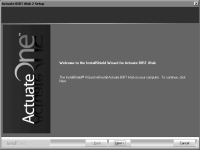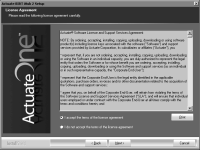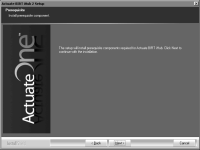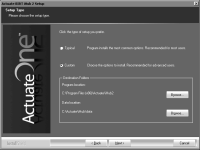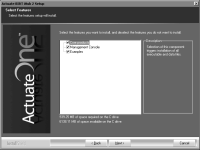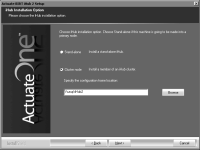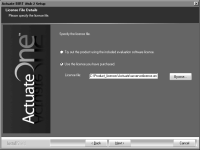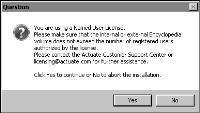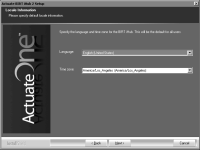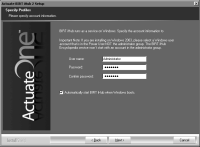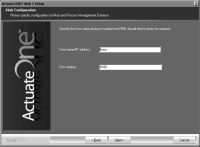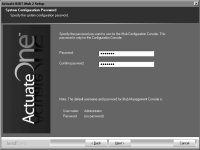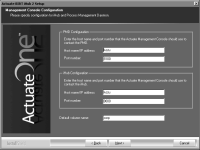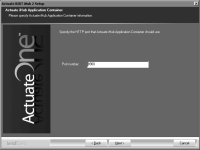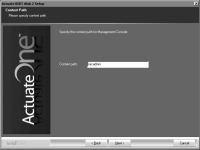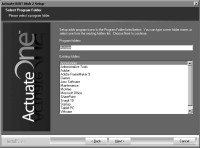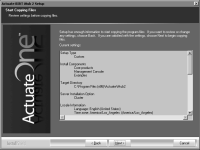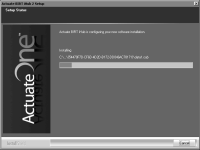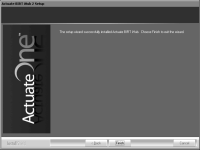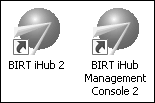Performing a wizard-based cluster node installation
This section assumes the Administrator has already performed the wizard-based Typical install to create a stand‑alone iHub on one computer and has performed the tasks described in the Preparing the iHub cluster environment section, earlier in this chapter. To create a stand‑alone iHub installation, see
“Performing a new installation” in
Chapter 2, “Installing BIRT iHub.” To prepare the stand‑alone iHub node for clustering, see
“Preparing the iHub cluster environment,” earlier in this chapter.
When creating a BIRT iHub cluster, the Administrator must install and run all cluster nodes using the same administrative user account. The following section describes how to install an iHub cluster node in the Windows operating system using the installation wizard.
How to install a cluster node in Windows
1 Download the iHub distribution package from an FTP software distribution site. Extract the files. Run the self-extracting executable file, ActuateBIRTiHub.exe. The welcome message appears, as shown in
Figure 5‑13. Choose Next.
Figure 5‑13 Viewing the welcome message
2 Read and accept the license agreement, as shown in
Figure 5‑14. Choose Next.
Figure 5‑14 Accepting the license agreement
3 The setup installs the prerequisite components that BIRT iHub requires, as shown in
Figure 5‑15. Choose Next.
Figure 5‑15 Installing Prerequisites
4 In Setup Type, select Custom, as shown in
Figure 5‑16.
Figure 5‑16 Selecting the custom installation
In Destination Folder, accept the default or choose a new destination folder for the Program and Data locations. Choose Next.
iHub uses the Program location to resolve the paths to all the binaries that it launches. The environment variable, AC_SERVER_HOME, points to the location of the iHub binaries. The default path for the program location is C:/Program Files (x86)/Actuate/iHub2.
iHub uses the Data location to store the iHub logs, iHub encyclopedia, including the PostgreSQL data, and all other run-time data. The environment variable, AC_DATA_HOME, points to the location of the iHub data. The default path for the data location is C:/Actuate/iHub/data.
Each iHub instance must to have its own AC_SERVER_HOME and AC_DATA_HOME folders. These folders cannot be shared by other nodes in a cluster.
5 In Select Features, select all features—Core products, Management Console, and Examples, as shown in
Figure 5‑17. A cluster node must have access to Configuration Console. Configuration Console installs with Management Console. Choose Next.
Figure 5‑17 Selecting features to install
6 In iHub Installation Option, select Cluster node to install iHub as a cluster node. Then specify the configuration home location, as shown in
Figure 5‑18.
Figure 5‑18 Choosing the option to install a node
The configuration home location is the shared directory containing the acserverconfig.xml, acserverlicense.xml, and acconfigowner.lock files for the cluster. The administrator should specify the location using the Universal Naming Convention (UNC) Format.
In an iHub installation, the configuration files are located in AC_DATA_HOME\config\iHub2 by default. If the shared configuration folder is in this default location on a server named urup, then the administrator should specify \\urup\iHub2 as the path.
Choose Next.
7 In License File Details, select Use the license that you purchased. Choose Browse then navigate to and choose the license file, as shown in
Figure 5‑19. Choose Next. Alternatively, choose Try out the product using the included evaluation software license if you do not have a purchased license.
Figure 5‑19 Specifying the license file
If installing using a named user license, a prompt appears advising you to check that the volume does not exceed the number of registered users authorized by the license, as shown in
Figure 5‑20.
Figure 5‑20 Viewing the named user license question
Choose Yes to continue the installation.
8 In Locale Information, choose Next to accept the default language and time zone, as shown in
Figure 5‑21. Alternatively, choose the language and locale settings for your region.
Figure 5‑21 Specifying a language
9 In Specify Profiles, type the user name, password, and confirm the password for the account used to start the Actuate BIRT iHub service, as shown in
Figure 5‑22. The account must be a member of the Administrators group. Actuate recommends that you limit access to this account for security reasons.
If you are installing on Windows 2003, specify a user account that is in the Power Users not the Administrators group. A user account in the Administrators group cannot start the Actuate BIRT iHub service.
Accept Automatically start iHub when Windows boots, as shown in
Figure 5‑22. If you deselect this option, you must start the service manually from Windows Services. Choose Next.
If prompted to add Log on as a service privilege, choose Yes.
Figure 5‑22 Specifying the account for running the iHub service
10 In iHub Configuration, shown in
Figure 5‑23, type the cluster node name or IP address for the node. Type a port number or accept the default port number, 8100. The Actuate BIRT iHub service on Windows binds to this port number to listen for requests. Choose Next.
Figure 5‑23 Identifying the cluster node and port to bind iHub service
11 In System Configuration Password, type a Configuration Console password, as shown in
Figure 5‑24. Note that the default user name for Management Console is Administrator with no password. Choose Next.
Figure 5‑24 Specifying the password for using Configuration Console
12 If you chose to install Management Console in step 5, complete the following steps:
1 Specify the following information, as shown in
Figure 5‑25. Choose Next:

Host name and port number for the following items:

PMD (Process Management Daemon) Configuration

iHub Configuration

Default volume name
Figure 5‑25 Specifying the Management Console Configuration
2 In Actuate iHub Application Container, type the port number that the iHub Application Container uses, or accept the default port number, 8900, as shown in
Figure 5‑26. Choose Next.
Figure 5‑26 Specify the port number for iHub Application Container
3 In Context Path, type the context path for Management Console or accept the default path, /acadmin, as shown in
Figure 5‑27. Choose Next.
Figure 5‑27 Specifying the context path
4 In Select Program Folder, specify a folder name containing the iHub icons that are used to launch the consoles, or accept the default name, Actuate, as shown in
Figure 5‑28. Choose Next.
Figure 5‑28 Specifying a program folder
13 In Start Copying Files, review the settings shown in
Figure 5‑29. Choose Next to start copying files.
Figure 5‑29 Reviewing settings before copying files
Setup Status displays an indicator showing how the installation is progressing, as shown in
Figure 5‑30.
Figure 5‑30 Viewing setup status
14 When the setup success message appears, as shown in
Figure 5‑31. Choose Finish to exit the wizard.
Figure 5‑31 Exiting the installation wizard
15 The installation program prompts you to install the online help from the following location, as shown in
Figure 5‑32:
http://www.actuate.com
Figure 5‑32 Viewing the install online help and manuals prompt
To install the online help and PDF manuals from this location, in Windows choose Start➛ Actuate➛Update Documentation.
16 If you chose to install Management Console in step 4, the installation program installs shortcuts on the desktop, as shown in
Figure 5‑33.
Figure 5‑33 Viewing BIRT iHub shortcuts on the desktop
These shortcuts provide access to the following iHub components:

BIRT iHub Management Console 2
Launches Management Console to administer an Encyclopedia volume, set up user accounts, and run designs.

BIRT iHub 2
Opens Welcome to Actuate BIRT iHub from which you can log in to Information Console to perform tasks, such as accessing folders and viewing documents.
